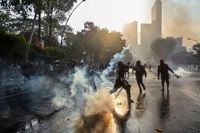Indonesia was rocked by a wave of violent protests on August 29, 2025, after the death of a motorcycle taxi driver, Affan Kurniawan, who was run over by a police tactical vehicle during a rally against low wages and financial perks for lawmakers. What began as outrage over one man’s tragic death quickly spiraled into the country’s largest and most destructive demonstrations since President Prabowo Subianto took office less than a year ago.
According to AFP, the flashpoint of the unrest occurred in Makassar, the biggest city on the eastern island of Sulawesi. There, anger and frustration boiled over as hundreds of protesters descended on both the provincial and city council buildings. The demonstrations, initially marked by rock-throwing and Molotov cocktails, escalated into chaos when protesters stormed the buildings and set them ablaze. The city council building was soon engulfed in flames as onlookers cheered and clapped, with few security forces in sight. One man could be heard shouting, "There are people upstairs!" as the fire raged, smoldering debris falling from the roof and charred cars flickering with flames nearby.
Rahmat Mappatoba, secretary of the Makassar city council, confirmed to AFP that three people died as a result of the fire. "They were trapped in the burning building," he said, blaming protesters for igniting the blaze. "Usually during a demonstration, protesters only throw rocks or burn a tyre in front of the office. They never stormed into the building or burned it." Two workers died at the scene, and a third—a civil servant—succumbed to injuries in hospital. At least four others were injured and required medical treatment.
By the next morning, the city council building had become a blackened wreck, surrounded by dozens of charred cars, as residents gathered to inspect the devastation. The South Sulawesi provincial council building was also set ablaze overnight, with protesters attempting to knock down its gates and storm the premises. Media footage showed Makassar transformed, its government center a scene of destruction and disbelief.
The unrest was not limited to Makassar. Protests erupted across Indonesia’s vast archipelago, including in major cities such as Jakarta, Yogyakarta, Bandung, Semarang, Surabaya, and Medan. In Jakarta, hundreds massed outside the headquarters of the elite Mobile Brigade Corp (Brimob), the paramilitary police unit blamed for Kurniawan’s death. Protesters threw firecrackers as police responded with tear gas. Some demonstrators attempted to tear down the gates and pulled a sign from the building’s facade, according to AFP reports.
Protests also flared in Indonesia’s tourist hotspots. In Bali, hundreds of students and motorcycle taxi drivers gathered in front of police headquarters. On the neighboring island of Lombok, demonstrators stormed a council building in the provincial capital Mataram and set it on fire, even as police tried to disperse them with tear gas. Surabaya, too, saw crowds rallying outside the East Java police headquarters. The scale and intensity of the protests were unlike anything seen since President Prabowo Subianto assumed office, testing his leadership and the government’s resolve.
In response to the violence and mounting public anger, police detained seven officers for questioning in connection with Kurniawan’s death. National police chief Listyo Sigit Prabowo announced on August 30 that the officers would face an ethics trial, which could last a week. "If they are guilty, there's room for us to process the case as a crime," he said at a news conference. The move was seen as an attempt to demonstrate accountability and restore public trust, though skepticism lingered among protesters and civil society groups.
President Prabowo Subianto, himself a former general, moved quickly to address the crisis. He urged calm and ordered a thorough investigation into the incident, promising that those responsible would be held to account. In a message posted on Instagram, Prabowo pledged government support for Kurniawan’s family and shared images of himself visiting them at their home. State Secretary Prasetyo Hadi announced that the president had canceled a planned trip to China for a military parade commemorating the end of World War II, choosing instead to remain in Indonesia to monitor the unfolding situation.
The protests were fueled not only by outrage over police brutality but also by broader discontent with government policies. Demonstrators voiced anger over widespread budget cuts, which have been implemented to fund Prabowo’s populist initiatives, including a billion-dollar free meal program. Many Indonesians, struggling with stagnant wages and rising living costs, saw the government’s actions as out of touch with their daily realities.
Technology played an unexpected role in the protests as well. TikTok, a platform with more than 100 million users in Indonesia, temporarily suspended its live feature for "a few days" in response to the unrest, reflecting the power of social media to amplify dissent and organize demonstrations. Footage of the protests—especially the moment Kurniawan was run over—spread rapidly online, fueling outrage and mobilizing new waves of demonstrators.
By August 30, South Sulawesi’s military chief Windiyatno declared that the situation in Makassar had "now returned to normal." Yet, the scars of the violence remained visible in the city’s charred government buildings and in the hearts of those who lost loved ones. The aftermath left many Indonesians questioning the path forward for their country. Would the government’s promises of accountability and reform be enough to heal the wounds, or would deeper changes be required?
While the protests have subsided for now, the events of August 29-30 have left an indelible mark on Indonesia’s political landscape. President Prabowo faces a critical test of leadership, balancing the need for order with demands for justice and meaningful reform. The coming weeks will reveal whether his administration can navigate these turbulent waters—and whether Indonesia’s democracy can emerge stronger from this crucible of crisis.

